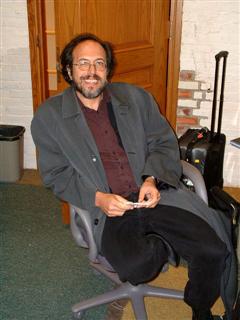With our growing resources, the Lifeboat Foundation has teamed with the Singularity Hub as Media Sponsors for the 2010 Humanity+ Summit. If you have suggestions on future events that we should sponsor, please contact [email protected].

 The summer 2010 “Humanity+ @ Harvard — The Rise Of The Citizen Scientist” conference is being held, after the inaugural conference in Los Angeles in December 2009, on the East Coast, at Harvard University’s prestigious Science Hall on June 12–13. Futurist, inventor, and author of the NYT bestselling book “The Singularity Is Near”, Ray Kurzweil is going to be keynote speaker of the conference.
The summer 2010 “Humanity+ @ Harvard — The Rise Of The Citizen Scientist” conference is being held, after the inaugural conference in Los Angeles in December 2009, on the East Coast, at Harvard University’s prestigious Science Hall on June 12–13. Futurist, inventor, and author of the NYT bestselling book “The Singularity Is Near”, Ray Kurzweil is going to be keynote speaker of the conference.
 Also speaking at the H+ Summit @ Harvard is Aubrey de Grey, a biomedical gerontologist based in Cambridge, UK, and is the Chief Science Officer of SENS Foundation, a California-based charity dedicated to combating the aging process. His talk, “Hype and anti-hype in academic biogerontology research: a call to action”, will analyze the interplay of over-pessimistic and over-optimistic positions with regards of research and development of cures, and propose solutions to alleviate the negative effects of both.
Also speaking at the H+ Summit @ Harvard is Aubrey de Grey, a biomedical gerontologist based in Cambridge, UK, and is the Chief Science Officer of SENS Foundation, a California-based charity dedicated to combating the aging process. His talk, “Hype and anti-hype in academic biogerontology research: a call to action”, will analyze the interplay of over-pessimistic and over-optimistic positions with regards of research and development of cures, and propose solutions to alleviate the negative effects of both.
The theme is “The Rise Of The Citizen Scientist”, as illustrated in his talk by Alex Lightman, Executive Director of Humanity+:

“Knowledge may be expanding exponentially, but the current rate of civilizational learning and institutional upgrading is still far too slow in the century of peak oil, peak uranium, and ‘peak everything’. Humanity needs to gather vastly more data as part of ever larger and more widespread scientific experiments, and make science and technology flourish in streets, fields, and homes as well as in university and corporate laboratories.”
Humanity+ Summit @ Harvard is an unmissable event for everyone who is interested in the evolution of the rapidly changing human condition, and the impact of accelerating technological change on the daily lives of individuals, and on our society as a whole. Tickets start at only $150, with an additional 50% discount for students registering with the coupon STUDENTDISCOUNT (valid student ID required at the time of admission).
With over 40 speakers, and 50 sessions in two jam packed days, the attendees, and the speakers will have many opportunities to interact, and discuss, complementing the conference with the necessary networking component.
Other speakers already listed on the H+ Summit program page include:
- David Orban, Chairman of Humanity+: “Intelligence Augmentation, Decision Power, And The Emerging Data Sphere”
- Heather Knight, CTO of Humanity+: “Why Robots Need to Spend More Time in the Limelight”
- Andrew Hessel, Co-Chair at Singularity University: “Altered Carbon: The Emerging Biological Diamond Age”
- M. A. Greenstein, Art Center College of Design: “Sparking our Neural Humanity with Neurotech!”
- Michael Smolens, CEO of dotSUB: “Removing language as a barrier to cross cultural communication”
New speakers will be announced in rapid succession, rounding out a schedule that is guaranteed to inform, intrigue, stimulate and provoke, in moving ahead our planetary understanding of the evolution of the human condition!
H+ Summit @ Harvard — The Rise Of The Citizen Scientist
June 12–13, Harvard University
Cambridge, MA
You can register at http://www.eventbrite.com/event/648806598/friendsofhplus/4141206940.
 Lee Smolin is said to believe (according to personal communication from Danila Medvedev who was told about it by John Smart. I tried to reach Smolin for comments, but failed) that global catastrophe is impossible, based on the following reasoning: the multiverse is dominated by those universes that are able to replicate. This Self-replication occurs in black holes, and in especially in those black holes, which are created civilizations. Thus, the parameters of the universe are selected so that civilization cannot self-destruct before they create black holes. As a result, all physical processes, in which civilization may self-destruct, are closed or highly unlikely. Early version of Smolin’s argument is here:
Lee Smolin is said to believe (according to personal communication from Danila Medvedev who was told about it by John Smart. I tried to reach Smolin for comments, but failed) that global catastrophe is impossible, based on the following reasoning: the multiverse is dominated by those universes that are able to replicate. This Self-replication occurs in black holes, and in especially in those black holes, which are created civilizations. Thus, the parameters of the universe are selected so that civilization cannot self-destruct before they create black holes. As a result, all physical processes, in which civilization may self-destruct, are closed or highly unlikely. Early version of Smolin’s argument is here: